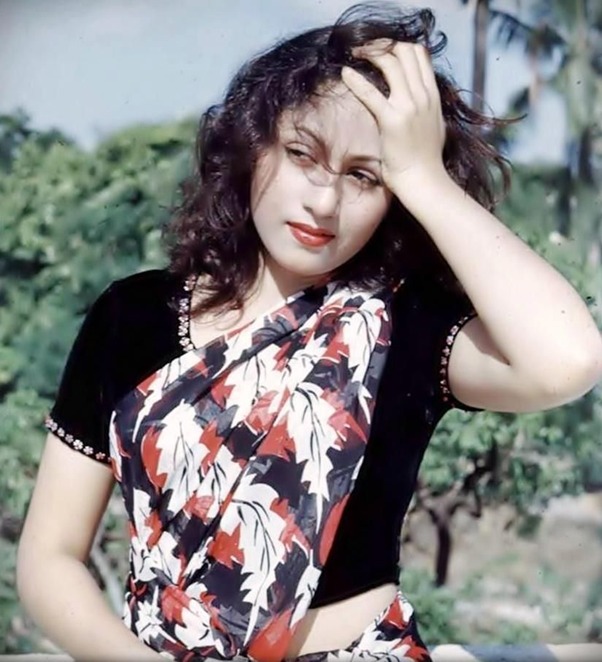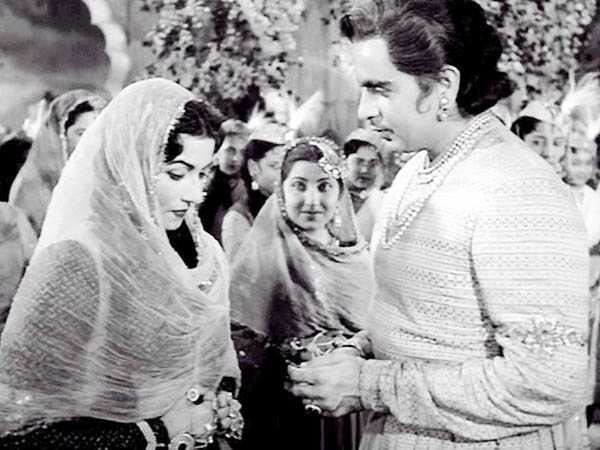A thing of beauty is a joy for ever
Its loveliness increases;
it will never pass into nothingness
~ John Keats
Madhubala, the unparalleled vision of love on screen, etched in minds forever when she appeared as a mysterious beauty searching for love, she dazzled the film world with her presence delightfully moving between beauty and tragedy. She was a part of seventy films none as iconic as her own life. An impressive life cut short by a fatal illness, fifty years later, her smile, playful laughter, and the soft vulnerability of her face still lights up the screens and set hearts to fire.
Born on February 14, 1933 to a poor pashtun family, she was Mumtaz Begum Jahan Dehlavi. The day coincided with Valentine’s Day; love would elude her all her life. In search of a better life, her father, Ataullah Khan soon moved from Peshwar to Bombay, where the co-founder of Bombay Talkies, Devika Rani, saw the young girl and gave her the name, Madhubala meaning sweet maiden. With a new name she set out to take the first steps in the Indian film industry leaving behind not just the life she had known but also her childhood sweetheart, Latif. Years later Latif, an IAS Officer used visit her on every birthday, placing a rose on her grave.

Madhubala was born with a ventricular septal defect, colloquially known as ‘hole in the heart’ nevertheless she committed her life to support her family by doing as many films as possible in the short span of her life. It is heartbreaking to know that even as Madhubala’s vibrant exquisiteness grew on screen she was suffering from a fragility that many were not even aware of. She was aware that there was no treatment for her condition and therefore turned herself into a workaholic. Even when she threw up blood while shooting for Bahut Din Huwe she quickly resumed work and everyone presumed her to be alright, till she collapsed on the sets of Raj Kapoor’s 1957 film, Chalack.
When Madhubala became a star, India was still nascent nation; she exemplified the modern Indian woman who had broken the fetters of the colonial past. Never the one to fall into stereotypes she gracefully portrayed her roles be it the educated and socially conscious woman in social dramas like Amar, the innocent Dulari, the spoiled heiress in Mr. and Mrs. 55, the sensuous dancer in Howrah Bridge, a rebel in Chalti ka Naam Gaadi, mischievous investigating journalist in Kala Paani. She was also a part of Bollywood’s cult horror movie, Mahal, and had a whispered affair with its director Kamal Amrohi who was at that time already married to actress, Meena Kumari. Like everything else about her about her, even when her films went on to become huge hits, Madhubala never won an award. In her lifetime, her acting skills remained unappreciated.
The Indian audience weren’t the ones enchanted by her, she left the world spellbound, the New York based Theatre Arts magazine called her “the biggest star in the world” and Life sent James Burke to do a photo shoot of the star. The Italian American film director, Franz Capra Jr. offered her a job in Hollywood but her father who controlled her career, turned it down. In Greece, music composer Stellios Kazantzidis sang about her mesmerizing beauty.
Madhubala
Love me sweet
I long for you to come near me again.
Since I am lost I call your name with pain.

In 1951, two men came in the life of the playful and flirtatious Madhubala. In Badal she was paired opposite Premnath, but the affair was short lived and the relationship broke down on grounds of religion. Many believed that Premnath had also become aware of her affair with Dilip Kumar as she wrote the same letter to both of them. Dilip Kumar was by then, an established star and ten years older to her. She was paired opposite him in Tarana and she fell head over heels in love with him, and sent him a rose and there began a long romance. This candid act by Madhubala was a manifestation of her trying to subvert the conservative society and a testimony to her liberal beliefs. The two soon became the talk of the town starring in Sangdil and Amar and it was Dilip Kumar who suggested her name for the role of Anarkali in what would be become one of Hindi cinema’s most legendary films Mughal-e-Azam. The film was largely shot in black and white except for one sequence where in the Mughal palace not only does Anarkali declare her love for the Prince Salim before the disapproving Emperor Akbar, but also a defiant Madhubala breaks the norms of society by proclaiming her love Dilip Kumar, Pyaar Kiya Toh Darna Kya.
The film is memory to their love and even though the two do not even embrace on screen, the scene where Salim caresses Anarkali’s face with a feather remains one of Indian cinema’s most erotic scenes. The film took almost ten years to make and by the time it was released Madhubala and Dilip Kumar had long separated. Even though she believed, “No peace or happiness is possible in life without true love,” she was caught between her father and her lover and chose her family over love.
By the time Mughal-e-Azam hit the screens in 1960, she had married, Kishore Kumar. The couple were a huge sensation on screen but off screen they were informed by doctors that she did not have much time to live. Faced with opposition from his family, Kishore Kumar divorced his wife, converted to Islam and married Madhubala in 1960. His family refused to accept her and things went from bad to worse and Madhubala moved back to her own home to abate the tension in the Kumar household. To only accentuate the tragedy, Kishore Kumar brought her a house to live in but left her forever, maybe because he wanted to detach himself from her so that the final separation did not hurt. He bore her medical expenses and remained married to her till the end.
For the next few years she did do a few successful movies but her health began to deteriorate. She even ventured into direction with Farz Aur Ishq. Even before the film could start its pre production stage she died on Feb. 23, 1969, less than days after her 36th birthday. She was laid to rest at Santa Cruz, Mumbai, buried with her diary.
In death she continues to remain the personification of beauty, charm and dalliance, to her admirers, there will be no one as seductively charismatic as Madhubala.
Unki tamanna dil mein rahegi
Shamma isi mehfil mein rahegi
Ishq mein jeena ishq mein marnaa
Ishq mein jeena ishq mein marnaa
Aur humein ab karna kyaa
Jab pyaar kiyaa to darna kyaa


















